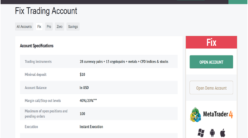Options trading, with its diverse range of methods and approaches, has gained significant popularity as an investment mechanism within the UK’s financial market. This article guides investors interested in exploring the intricacies of options trading strategies.

By shedding light on the fundamental techniques involved, readers will gain valuable insights into this complex yet advantageous terrain. Whether you are a seasoned investor or a novice looking to expand your investment portfolio, this article will equip you with the knowledge and tools to navigate the dynamic world of options trading.
The essence of options trading
At its core, options trading is the purchase or sale of an options contract. This contract allows the buyer, with no obligation, to trade an underlying asset within a specific time frame. This flexibility makes options trading so appealing to investors as it allows for profit potential in both bullish (rising) and bearish (falling) markets.
Call vs put options
The two main types of options are call and put options. A call option allows the buyer to trade an underlying asset, while a put option will allow the buyer to sell an underlying asset. When purchasing either option, investors pay a premium for this right.
Understanding strike price and expiration date
The strike price is the price at which the underlying asset can be traded. The expiration date, on the other hand, is the deadline by which the option contract must be exercised. It is crucial to choose a strike price and expiration date that align with your investment objectives and market expectations.
Key options trading strategies
Now that we have a basic understanding of options trading, let us delve into some essential techniques used in this investment approach.
Covered call strategy
This strategy is a widely adopted investment strategy known as covered call writing. It involves selling call options on an underlying asset the investor owns. In this strategy, if the option is exercised, the investor must sell the purchase at the predetermined strike price. However, they get to keep the premium received from selling the option.
This approach can be particularly advantageous for investors looking to generate additional income from their existing assets while mitigating downside risk. By employing covered call writing, investors can enhance their overall returns and optimise their portfolios.
Protective put strategy
The protective put strategy protects against potential losses in a portfolio. It involves buying put options on an underlying asset that the investor already owns. If the market experiences a downturn, the value of the put option will increase, partially offsetting any losses incurred from owning the underlying asset.
This strategy can be helpful for investors looking to safeguard their investments and limit downside risk. However, it is essential to note that purchasing put options can be costly, and they have an expiration date, so the investor must continuously monitor their investments to ensure the timely execution of this strategy.
Long straddle strategy
The long straddle strategy is a more aggressive approach where investors purchase both a call and a put option on the same underlying asset. This technique is employed when investors anticipate significant market movement but still determine the direction.
If the market moves in either direction, the investor can profit from exercising one of the options while letting the other expire. This trading strategy can be beneficial for investors who have a high-risk tolerance and believe that volatility will increase in the market.
Short straddle strategy
The short straddle strategy is unlike the long straddle strategy. Instead of purchasing options, investors sell both a call option and a put option simultaneously on the same underlying asset.
This technique is employed when investors believe the market will remain relatively stable, resulting in both options expiring worthless.
Investors can profit from this strategy by collecting premiums while limiting downside risk due to the expiration date. However, it is essential to note that this strategy has a higher risk as there is unlimited loss potential if the market experiences significant movements.
Risks and rewards
Like any investment approach, options trading comes with its own set of risks and rewards. Understanding these risks and rewards is essential for investors in the UK looking to enter the world of options trading strategies.
Potential rewards
One of the primary rewards of options trading is its flexibility. As discussed, options trading allows for profit potential in bullish and bearish markets, making it a versatile investment mechanism. Additionally, options contracts typically require less capital than purchasing the underlying asset. Investors can generate higher returns with a smaller initial investment.
Potential risks
The most prevalent risk of options trading is the possible loss of the premium paid for the contract. If the market does not move in the anticipated direction, the investor may lose their entire investment. Options contracts have an expiration date, which means investors must continuously monitor their investments and execute timely trades to maximise profits and minimise losses.
Final thoughts
Options trading strategies can provide investors with a valuable tool to diversify their portfolios and generate higher returns. It is vital to thoroughly understand the risks involved and conduct thorough research before embarking on this investment approach. By familiarising yourself with different options trading strategies and their potential rewards and risks, you can make informed decisions when managing your investments in the UK market.





